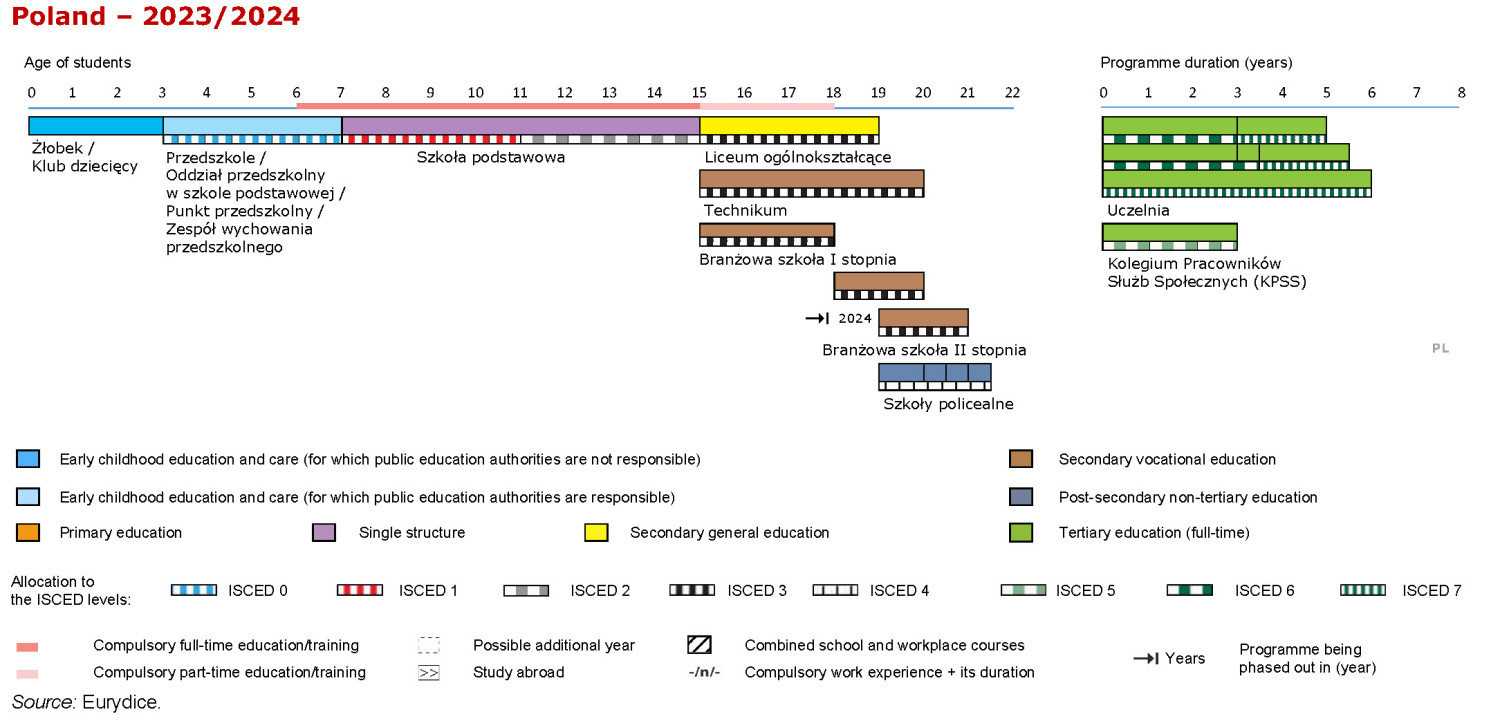THE POLISH EDUCATION SYSTEM IN BRIEF
Update April 2024
Structure of the education system

Compulsory education
Full-time compulsory education lasts for 9 years. It comprises the last year of pre-school education and 8 years of primary school education.
In the Polish educational legislation full-time compulsory schooling and part-time compulsory education are defined as follows:
- Full-time compulsory schooling
- Obligation to attend school by pupils aged 7-15 years.
- Part-time compulsory education
- Obligation to continue education in some form for pupils aged 15-18;
- May be implemented either in school settings (a student attends secondary school) or in non-school settings (e.g. a student follows vocational training offered by employers).
STAGES OF THE EDUCATION SYSTEM
ECEC
Institutions for children aged 0-3 years:
- crèche (żłobek)
- kids’ club (klub dziecięcy).
Attending a crèche/club is not obligatory, these institutions are not part of education system as they are supervised by the Ministry of Family, Labour and Social Policy.
Institutions for children aged 3-6 years:
- nursery school (przedszkole)
- pre-school class in a primary school (oddział przedszkolny w szkole podstawowej)
- pre-school unit (zespół wychowania przedszkolnego)
- pre-school centre (punkt przedszkolny).
Pre-school education is optional for 3-, 4- and 5-year-old children and obligatory for 6-year-olds. Every 3-, 4- and 5-year-old, however, has an entitlement to a place in a pre-primary setting in his/her community.
Compulsory education starts at the age of 7 in grade one of the primary school. All 6-year-olds have to attend a pre-school institution for one year in order to acquire basic skills before they start school.
Primary education (ISCED 1+2)
Primary education comprises 8 years of primary school (8-year single structure education) which is compulsory for all pupils (typically) aged 7-15.
It includes:
- grades 1-3 (early school education)
- grades 4-8 (teaching by subject).
At the end of grade 8 of primary school pupils take a compulsory external examination – 8th grader’s exam. The results of the exam together with end of school achievement influence admission to secondary schools.
Secondary education (ISCED 3)
Although this stage of education is not compulsory (or in fact compulsory part-time up to the age of 18, either in school or non-school setting), a vast majority of students continues education in secondary schools.
The structure of secondary education (ISCED 3) includes the following types of schools:
- 4-year general secondary school (liceum ogólnokształcące) [ISCED 344]
- 5-year technical secondary school (technikum) [ISCED 354]
- 3-year Stage I sectoral vocational school (branżowa szkoła I stopnia) [ISCED 353]
- 2-year Stage II sectoral vocational school (branżowa szkoła II stopnia) [ISCED 354].
Examinations
Graduates of general secondary schools and technical secondary schools may take the external secondary school leaving examination (egzamin maturalny) to obtain the certificate (świadectwo maturalne), which gives access to higher education. This possibility is also open to graduates of the Stage II sectoral vocational schools.
Students of vocational schools - sectoral vocational schools and technical upper secondary schools - take the obligatory vocational examinations and upon passing these exams they receive a vocational diploma.
Post-secondary non-tertiary education (ISCED 4)
Post-secondary education is considered to be a part of secondary education. Post-secondary schools (szkoła policealna) are intended for graduates of general secondary schools who do not hold a świadectwo maturalne but still wish to obtain further vocational qualifications i.e. a vocational diploma.
The schools offer courses lasting from 1 to 2.5 years. The students of post-secondary schools and students of sectoral vocational schools and technical secondary schools take vocational exams of the same type.
Higher education (ISCED 5-8)
There are two types of Higher Education Institutions:
- university-type HEIs (uczelnia akademicka)
- non-university-type HEIs (uczelnia zawodowa).
They both offer first- and second-cycle programmes as well as long-cycle Master’s degree programmes while only university-type HEIs can offer third-cycle programmes (doctoral studies) and are authorized to award doctoral degrees. Non-university-type HEIs, on the other hand, tend to offer specialist, practical type of training programmes.
Studies are organised in the form of full-time (studia stacjonarne) or part-time (studia niestacjonarne) programmes.
First-cycle programmes lead to two types of degrees (equivalent of Bachelor’s degree):
- licencjat– - 3-4 years programme
- inżynier – 3.5-4 years programme.
Holders of the Bachelor’s degree can enter second-cycle (Master’s degree) programmes, which take 1.5-2 years depending on the area of study.
Only several fields of study offer long-cycle Master’s degree programmes that last for 4.5-6 years.
First-cycle, second-cycle and long-cycle Master’s programmes end with a diploma examination and students who have passed it are granted a relevant degree.
The Master’s degree (magister or its equivalent) entitles its holder to practice a given profession and provides access to third-cycle studies. They are organised in HEIs or Research and Development Institutions other than HEIs and last for 3-4 years.
Adult education
Adult education is open to adults who wish to complete school education on primary and secondary level or acquire new vocational qualifications and skills for professional or personal reasons.
It is organised in schools for adults: primary, general secondary and post-secondary ones.
In non-school settings adult education is organised by:
- continuing education centres
- vocational training centres
- vocational and continuing education centres
- HEIs as non-degree postgraduate programmes.
Training is also offered to the unemployed and to certain categories of people searching for a job.
Further information on the system may be found on the following websites:
- Ministry of National Education
- Ministry of Science and Higher Education
- Central Statistical Office (statistical data).

